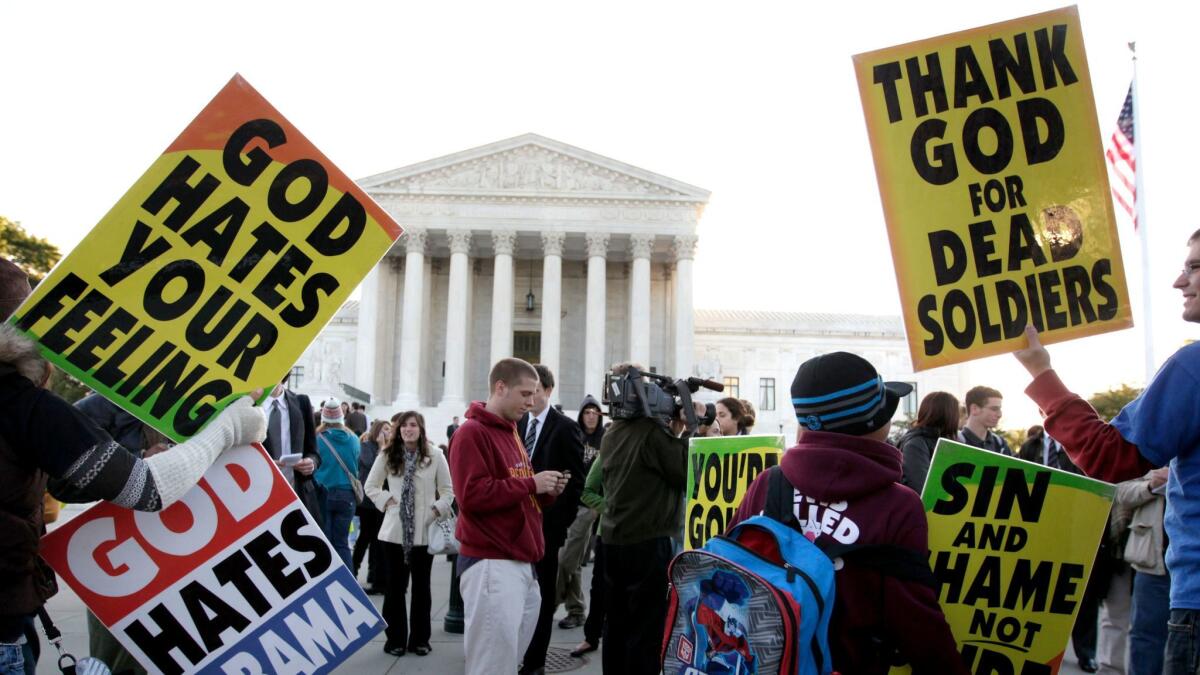Op-Ed: The case for restricting hate speech

- Share via
As a sociologist and legal scholar, I struggle to explain the boundaries of free speech to undergraduates. Despite the 1st Amendment—I tell my students—local, state, and federal laws limit all kinds of speech. We regulate advertising, obscenity, slander, libel, and inciting lawless action to name just a few. My students nod along until we get to racist and sexist speech. Some can’t grasp why, if we restrict so many forms of speech, we don’t also restrict hate speech. Why, for example, did the Supreme Court on Monday rule that the trademark office cannot reject “disparaging” applications—like a request from an Oregon band to trademark “the Slants” as in Asian “slant eyes.”
The typical answer is that judges must balance benefits and harms. If judges are asked to compare the harm of restricting speech – a cherished core constitutional value – to the harm of hurt feelings, judges will rightly choose to protect free expression. But perhaps it’s nonsense to characterize the nature of the harm as nothing more than an emotional scratch; that’s a reflection of the deep inequalities in our society, and one that demonstrates a profound misunderstanding of how hate speech affects its targets.
Legally, we tell members of traditionally disadvantaged groups that they must live with hate speech except under very limited circumstances. The KKK can parade down Main Street. People can’t falsely yell fire in a theater but can yell the N-word at a person of color. College women are told that a crowd of frat boys chanting “no means yes and yes means anal” is something they must tolerate in the name of (someone else’s) freedom.
Because we are ‘free’ to be hateful, members of traditionally marginalized groups suffer.
At the same time, our regime of free speech protects the powerful and popular. Many city governments, for instance, have banned panhandling at the behest of their business communities. The legal justification is that the targets of begging (commuters, tourists, and consumers) have important and legitimate purposes for being in public: to get to work or to go shopping. The law therefore protects them from aggressive requests for money.
Consider also the protections afforded to soldiers’ families in the case of Westboro Baptist anti-gay demonstrations. When the Supreme Court in 2011 upheld that church’s right to stage offensive protetsts at veterans’ funerals, Congress passed the Honoring America’s Veterans’ Act, which prohibits any protests 300 to 500 feet around such funerals. (The statute made no mention of protecting LGBTQ funeral attendees from hate speech, just soldiers’ families).
So soldiers’ families, shoppers and workers are protected from troubling speech. People of color, women walking down public streets or just living in their dorm on a college campus are not. The only way to justify this disparity is to argue that commuters asked for money on the way to work experience a tangible harm, while women catcalled and worse on the way to work do not — as if being the target of a request for change is worse than being racially disparaged by a stranger.
In fact, empirical data suggest that frequent verbal harassment can lead to various negative consequences. Racist hate speech has been linked to cigarette smoking, high blood pressure, anxiety, depression and post-traumatic stress disorder, and requires complex coping strategies. Exposure to racial slurs also diminishes academic performance. Women subjected to sexualized speech may develop a phenomenon of “self-objectification,” which is associated with eating disorders.
These negative physical and mental health outcomes — which embody the historical roots of race and gender oppression — mean that hate speech is not “just speech.” Hate speech is doing something. It results in tangible harms that are serious in and of themselves and that collectively amount to the harm of subordination. The harm of perpetuating discrimination. The harm of creating inequality.
Instead of characterizing racist and sexist hate speech as “just speech,” courts and legislatures need to account for this research and, perhaps, allow the restriction of hate speech as do all of the other economically advanced democracies in the world.
Many readers will find this line of thinking repellent. They will insist that protecting hate speech is consistent with and even central to our founding principles. They will argue that regulating hate speech would amount to a serious break from our tradition. They will trivialize the harms that social science research undeniably associates with being the target of hate speech, and call people seeking recognition of these affronts “snowflakes.”
But these free-speech absolutists must at least acknowledge two facts. First, the right to speak already is far from absolute. Second, they are asking disadvantaged members of our society to shoulder a heavy burden with serious consequences. Because we are “free” to be hateful, members of traditionally marginalized groups suffer.
Laura Beth Nielsen is director of the legal studies program and professor of sociology at Northwestern University and research professor at the American Bar Foundation. She is the author of “License to Harass: Law, Hierarchy, and Offensive Public Speech.”
To read the article in Spanish, click here
Follow the Opinion section on Twitter @latimesopinion or Facebook
More to Read
A cure for the common opinion
Get thought-provoking perspectives with our weekly newsletter.
You may occasionally receive promotional content from the Los Angeles Times.









